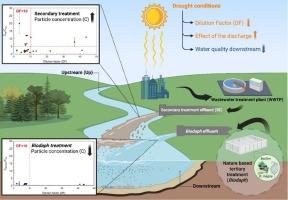A nature-based solution to mitigate the impact of reclaimed water discharge into a river under water scarcity conditions
IF 6.7
2区 工程技术
Q1 ENGINEERING, CHEMICAL
引用次数: 0
Abstract
Water scarcity in Mediterranean regions is a growing concern. Alternatives are necessary to meet the water demand from urban areas and to maintain ecological flows in rivers due to the decreased availability and the poor quality of water that is found during drought events. In these conditions, flow can be sustained through discharges from sewage plants. However, if river dilution factors are low, the discharges can endanger aquatic ecosystems. To mitigate these impacts, tertiary treatments are integrated into wastewater treatment plants to improve effluent quality. In this study, the impact of a wastewater treatment discharge in a river has been evaluated before and after the implementation of a nature-based tertiary treatment under different river dilution conditions. The water quality of the river as well as of the discharged effluent was assessed through the concentration of small-suspended sludge particles (d < 100 μm). The main findings of the manuscript were: (1) The concentration of small-suspended particles in the river, 50 m downstream the WWTP point of discharge was found to be lower, especially during periods with a low dilution factor, after the nature-based tertiary treatment was put in operation.
This was due to the effectiveness of the nature-based tertiary treatment in eliminating small particles (85.4 %) whereas large sludge particles (d > 100 μm) are also reduced (69.8 %) by sedimentation. (2) A predictive model to assess the impact of the treated wastewater discharge into the river was developed and calibrated. The model considers different percentages of water treated by the tertiary system in water scarcity scenarios.

一个基于自然的解决方案,以减轻在缺水条件下再生水排放到河流中的影响
地中海地区的缺水问题日益引起人们的关注。为了满足城市地区的用水需求和维持河流的生态流动,必须有其他选择,因为在干旱事件期间,水的可用性减少,水质差。在这些条件下,水流可以通过污水处理厂的排放来维持。然而,如果河流稀释系数较低,则会对水生生态系统造成危害。为了减轻这些影响,三级处理被纳入污水处理厂,以改善出水质量。在本研究中,在不同的河流稀释条件下,对实施基于自然的三级处理前后的河流废水处理排放的影响进行了评估。通过测定小悬浮污泥颗粒(d < 100 μm)的浓度,对河流水质及排放出水进行评价。论文的主要发现有:(1)采用自然三级处理后,污水处理厂排放点下游50 m的河流中小悬浮颗粒浓度较低,特别是在稀释系数较低的时期。这是由于基于自然的三级处理在去除小颗粒(85.4%)方面的有效性,而大污泥颗粒(d > 100 μm)也通过沉淀减少(69.8%)。(2)建立了污水排放影响的预测模型,并进行了标定。该模型考虑了在缺水情景下三级系统处理的不同百分比的水。
本文章由计算机程序翻译,如有差异,请以英文原文为准。
求助全文
约1分钟内获得全文
求助全文
来源期刊

Journal of water process engineering
Biochemistry, Genetics and Molecular Biology-Biotechnology
CiteScore
10.70
自引率
8.60%
发文量
846
审稿时长
24 days
期刊介绍:
The Journal of Water Process Engineering aims to publish refereed, high-quality research papers with significant novelty and impact in all areas of the engineering of water and wastewater processing . Papers on advanced and novel treatment processes and technologies are particularly welcome. The Journal considers papers in areas such as nanotechnology and biotechnology applications in water, novel oxidation and separation processes, membrane processes (except those for desalination) , catalytic processes for the removal of water contaminants, sustainable processes, water reuse and recycling, water use and wastewater minimization, integrated/hybrid technology, process modeling of water treatment and novel treatment processes. Submissions on the subject of adsorbents, including standard measurements of adsorption kinetics and equilibrium will only be considered if there is a genuine case for novelty and contribution, for example highly novel, sustainable adsorbents and their use: papers on activated carbon-type materials derived from natural matter, or surfactant-modified clays and related minerals, would not fulfil this criterion. The Journal particularly welcomes contributions involving environmentally, economically and socially sustainable technology for water treatment, including those which are energy-efficient, with minimal or no chemical consumption, and capable of water recycling and reuse that minimizes the direct disposal of wastewater to the aquatic environment. Papers that describe novel ideas for solving issues related to water quality and availability are also welcome, as are those that show the transfer of techniques from other disciplines. The Journal will consider papers dealing with processes for various water matrices including drinking water (except desalination), domestic, urban and industrial wastewaters, in addition to their residues. It is expected that the journal will be of particular relevance to chemical and process engineers working in the field. The Journal welcomes Full Text papers, Short Communications, State-of-the-Art Reviews and Letters to Editors and Case Studies
 求助内容:
求助内容: 应助结果提醒方式:
应助结果提醒方式:


